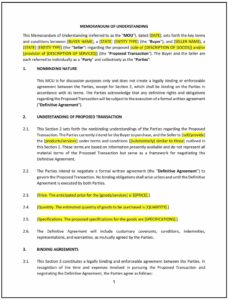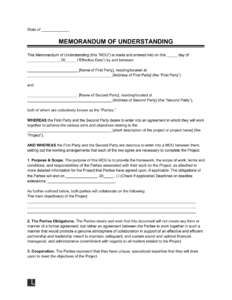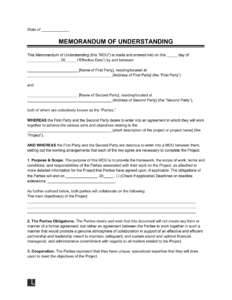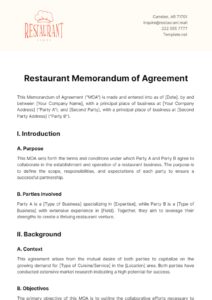Navigating the world of employment can sometimes feel like a complex puzzle, especially when you’re trying to set clear expectations without immediately diving into a full-blown legal contract. That’s where a Memorandum of Understanding, or MOU, comes into play. It’s a fantastic tool for laying out the groundwork, ensuring everyone is on the same page before making more formal commitments. Think of it as a handshake agreement, but written down and a bit more detailed, providing a clear path forward for both employers and potential team members.
Whether you’re an employer looking to onboard new talent for a specific project, or an individual wanting to ensure your role and responsibilities are well-defined, an employment memorandum of understanding template can be incredibly useful. It helps to clarify roles, responsibilities, expectations, and even timelines in a more flexible and less rigid manner than a traditional employment contract. This approach fosters a sense of mutual understanding and collaboration right from the start, setting a positive tone for the working relationship.
Understanding the Role of an Employment Memorandum of Understanding
An Employment Memorandum of Understanding (MOU) serves as a documented agreement between two or more parties, typically an employer and an employee or a group of employees, outlining their intentions and understanding regarding a specific employment relationship or project. Unlike a legally binding contract, an MOU is generally not enforceable in court unless specifically stated or it forms part of a larger, legally binding agreement. Its primary purpose is to articulate a common set of goals and expectations, creating a framework for cooperation and clarity. It’s particularly useful in situations where the full scope of an engagement might evolve, or where a less formal commitment is desired initially.
This document is incredibly versatile and can be used in various scenarios. For instance, it might precede a formal employment contract, allowing both parties to test the waters or to align on specific project parameters before a long-term commitment. It’s also frequently used for short-term projects, internships, volunteer positions, or even to detail temporary changes in an existing employment relationship, such as a secondment or a temporary change in responsibilities. The flexibility of an MOU makes it a valuable asset for fostering transparency and reducing potential misunderstandings down the line, ensuring that both sides have a shared vision of what success looks like.
One of the greatest benefits of utilizing an employment memorandum of understanding template is its ability to distill complex arrangements into clear, actionable points. It encourages open communication and negotiation between parties, as they collaboratively define the scope, objectives, and anticipated outcomes of their working relationship. This collaborative drafting process itself can be highly beneficial, as it ensures that both the employer and the employee feel heard and valued, contributing to a stronger professional bond from the outset.
When you’re looking for an employment memorandum of understanding template, you’ll often find sections dedicated to outlining the core elements of the agreement. These are crucial for ensuring the document serves its purpose effectively.
Key Components to Consider
- Parties Involved: Clearly identifies the employer and the employee(s) entering into the understanding.
- Purpose and Scope: Defines the reason for the MOU, whether it’s for a specific project, an internship, or a new role, and outlines the general activities or responsibilities.
- Duration: Specifies the intended start and end dates, if applicable, or clarifies that it is an ongoing understanding subject to review.
- Roles and Responsibilities: Provides a high-level overview of what each party is expected to do.
- Confidentiality: Details any requirements for protecting sensitive information.
- Resources and Support: Mentions any resources, training, or support the employer will provide.
- Dispute Resolution: Outlines a process for addressing disagreements, though often less formal than in a contract.
Having these elements clearly articulated in an employment memorandum of understanding template helps to prevent ambiguities and sets a professional tone.
Crafting an Effective Memorandum of Understanding
When it comes to drafting an employment memorandum of understanding, clarity and mutual understanding are paramount. While it’s generally less formal than a contract, an MOU still needs to be precise enough to guide the parties involved. Start by identifying the core objectives and the specific nature of the employment relationship or project you want to document. Think about what success looks like for both the employer and the employee, and try to capture those expectations in straightforward language. Avoiding jargon and overly technical terms will make the document accessible and understandable for everyone involved, reducing the likelihood of misinterpretation.
An effective MOU focuses on establishing a foundation of trust and shared direction. It’s not about imposing strict legal obligations, but rather about aligning intentions and fostering a cooperative environment. Therefore, involving both parties in the drafting process, or at least in reviewing and providing input, can significantly enhance its effectiveness. This collaborative approach ensures that all perspectives are considered and that the final document truly reflects a mutual understanding. Remember, the goal is to create a living document that serves as a useful reference point throughout the engagement.
To ensure your memorandum of understanding is as robust as possible, consider these practical tips:
- Use Simple, Direct Language: Avoid legalistic phrasing where conversational alternatives exist.
- Be Specific Where Necessary: While flexible, certain details like project timelines or expected deliverables benefit from specificity.
- Include an “Effective Date”: Clearly state when the understanding begins.
- Review and Revise: Encourage both parties to read the document thoroughly and suggest amendments before signing.
- Clarify Non-Binding Nature: If the MOU is intended to be non-binding, it’s often wise to include a statement to that effect to manage expectations.
By following these guidelines, you can create an MOU that genuinely supports a productive and harmonious working relationship.
Utilizing an employment memorandum of understanding template is a smart move for any organization or individual looking to formalize their intentions without the immediate commitment of a rigid legal contract. It offers a flexible yet structured way to define expectations, roles, and responsibilities, fostering clear communication and a shared vision from the outset. This foundational document can significantly contribute to smoother operations and more successful collaborations, acting as a compass for all parties involved.
Ultimately, whether you’re initiating a new project, onboarding an intern, or simply clarifying the scope of work, a well-drafted Memorandum of Understanding helps build a framework of trust and transparency. It’s an invaluable tool for ensuring that everyone involved is aligned on objectives and committed to achieving shared goals, paving the way for a more efficient and harmonious professional journey.



